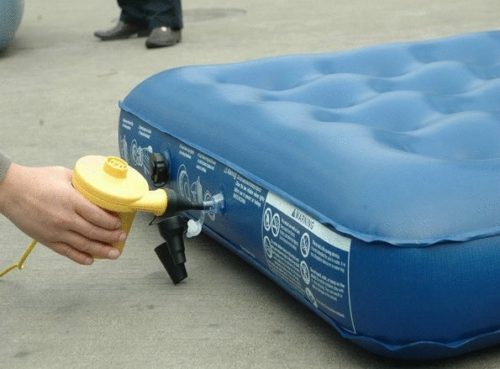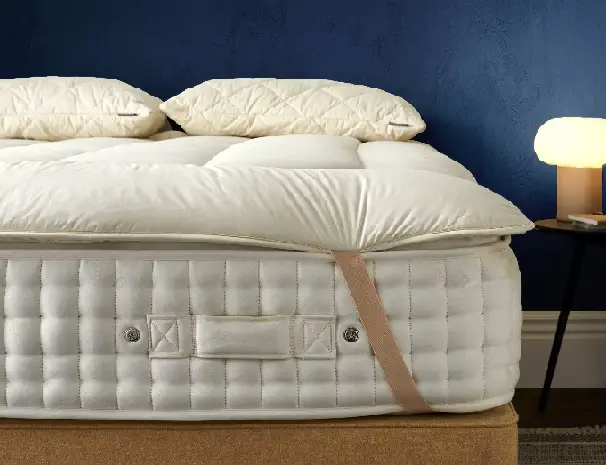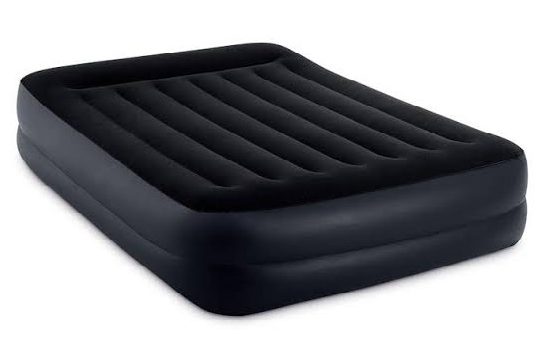Although inflatable air beds have a reputation for being comfortable, it’s not uncommon for them to lose air while you’re using them, which can leave you feeling irritated and deprived of sleep. In this article, we will investigate why air mattress deflate, the factors that contribute to the deflation of air mattresses and offer helpful suggestions for avoiding and resolving this problem so that you can have a good night’s sleep.
Here are the reasons why:
Table of Contents
Why Air Mattress Deflate: Improper Use
Incorrect use is a leading cause of air mattresses losing their air during the night. Unfortunately, many buyers fail to read and adhere to the mattress’s included instructions.
However, the effectiveness and durability of your inflatable bed will suffer if you skip any of the required stages. Carefully reading and following the included air mattress inflation instructions is essential.
Here’s why:
1. Optimal Performance
There’s a good reason for each of the manual’s specified procedures. They show you just how much air to put into the mattress so it works perfectly every time. If you follow the steps in the guide, you should be able to inflate the mattress to the right level of hardness and air pressure for a restful night’s sleep.
2. Longevity
A properly used air mattress not only performs better right away but also lasts longer. If you don’t follow the directions, you risk stressing the mattress out of proportion by either overinflating it or underinflating it.
This may cause damage, leakage, and a shorter mattress lifespan over time.
3. Air Pressure Maintenance
You can keep the desired air pressure throughout the night by following the instructions. The mattress maintains its firmness and doesn’t lose air over time when it is properly inflated.
This makes sure that when you wake up, your mattress is fully inflated and prepared for another night of sound sleep.
4. Avoiding Structural Issues
The air mattress’ seams and valves may become strained from improper use. This can eventually lead to the weakening or failure of these crucial parts, leading to air leaks and deflation.
You can lessen the chance of structural problems and benefit from a dependable air mattress for a longer duration of time by comprehending and putting into practice the proper inflation and deflation processes.
Read the manual to maximize your air mattress and avoid deflation. Inflate, deflate, and maintain as instructed. Doing so optimizes performance, lifespan, and sleep quality.
Proper air mattress utilization creates a comfortable, durable sleep surface. Before inflating your mattress next time, take a few minutes to read the instructions and enjoy uninterrupted sleep on a fully inflated bed.
Why Air Mattress Deflate: Temperature
Variations in temperature may also play a significant role in the deflation of air mattresses. As the sun goes down and the temperature in the room drops, the air inside the mattress undergoes a condensation process that causes the air pressure to drop.
Knowing how the temperature influences the inflation of your air mattress will help you maintain a consistent level of comfort throughout the night.
Here’s a closer look at how temperature affects air mattresses:
The Ideal Gas Law and Condensation
The Ideal Gas Law comes into play while attempting to comprehend why air mattresses deflate in response to temperature changes. According to this scientific theory, if a gas’s volume and molecule count remains constant when a gas’s temperature drops, so does its pressure.
The air inside the mattress cools off at the same time that the room does throughout the night. The outcome is a reduction in the kinetic energy of the air molecules as they slow down. The mattress becomes softer and feels deflated as a result of this drop in kinetic energy and subsequent drop in air pressure.
Experiment with Footballs and Temperature
Footballs were used in a remarkable experiment by NBC Sports’ Sports Science to demonstrate how temperature affects air pressure. Footballs were subjected to an hour-long experiment at a temperature of 10 degrees Fahrenheit. The air pressure in the footballs dropped significantly during this time, from 13.5 PSI (pounds per square inch) to 11 PSI.
Although the experiment only employs footballs, the idea also works with air mattresses. The air inside the mattress condenses when it is exposed to low temperatures during the night, resulting in a drop in air pressure and subsequent deflation.
Managing Temperature to Prevent Deflation
To mitigate the effects of temperature and prevent overnight deflation of your air mattress, consider the following tips:
1. Temperature Control
By adjusting the thermostat or adding additional insulation, such as blankets or mattress toppers, you can keep the room’s temperature constant throughout the night. You can lessen the effect of moisture and lower the chance of deflation by maintaining a somewhat constant room temperature.
2. Pre-Inflation Strategy:
Consider slightly overinflating the mattress before going to bed if you anticipate a big drop in room temperature during the course of the night. The mattress can stay firm enough until morning thanks to the initial overinflation, which offsets the anticipated drop in air pressure.
3. Re-Inflation Routine:
Include a re-inflation method in your morning routine if you find your air mattress has slightly lost air over night as a result of temperature fluctuations. You may get the desired firmness back by adding a fast burst of air using a manual or electric pump, and you can start the day with a completely filled mattress.
4. Insulating Layers:
Between the air mattress and your bedding, add an insulating layer, such as a mattress pad or thermal blanket. This additional barrier decreases temperature changes and aids with heat retention, decreasing the likelihood of substantial deflation.
You can more effectively control inflation and avoid overnight deflation by comprehending how temperature affects air mattresses and putting these strategies into practice.
You’ll consistently have a comfortable resting surface if you maintain a steady room temperature and take preventative precautions. You’ll also be able to wake up each morning to a completely filled air mattress.
Why Air Mattress Deflate: Pumps
External pumps are frequently used with air mattresses, and these external pumps are a common cause of air mattress deflation. After the mattress has inflated, a small amount of air is often lost when the pump is disconnected, lowering the mattress’s overall air pressure.
You can keep a properly inflated air mattress for a restful night’s sleep by being aware of this issue and looking for alternate solutions.
Use air mattress pumps such as; Etekcity Electric Air Pump, AGPTEK Portable Quick-Fill Air Pump and FLEXTAILGEAR MAX 2020 Portable air pump to keep your air mattress properly inflated.
. Here’s a closer look at the problems associated with pumping and how to address it:
The Problems with External Pumps
Air mattresses are frequently inflated using external pumps. Although they are practical and effective, they are not totally airtight. A little quantity of air escapes when the pump is removed from the mattress, causing the air pressure to drop.
Over time, this slow air loss may cause the mattress to seem deflated.
Built-in Pump Solutions
Many air mattress manufacturers have offered built-in pump solutions to solve the pumping problem. These mattresses have built-in pumps that provide airtight sealing and do not require an additional pump.
You can blow up your mattress using a built-in pump and then remove the pump without significantly losing air.
Built-in pumps offer several advantages, including:
Convenience
The inflating procedure is made simpler with built-in pumps. The mattress is easily inflated to the desired hardness with the simple push of a button or turn of a dial. You will save time and effort by not having to constantly connect and unhook an external pump as a result.
An airtight seal
These mattresses have inbuilt pumps that offer airtight sealing, minimizing air loss during inflation and detachment. Ensuring a constant air pressure inside the mattress, lowers the chance of deflation as you sleep.
Quicker Inflation
Mattresses can be swiftly inflated using built-in pumps, usually in four to six minutes. This quick inflation process makes it possible to quickly and efficiently set up your bed and guarantees that it is prepared for usage.
Choosing the Right Air Mattress
When looking for an air mattress, weigh your options to see if a built-in pump option is the best fit for you. Consider your tastes and needs, such as performance over the long term, usability, and convenience.
A mattress with an integrated pump can be the best choice for you if you value simplicity and little air loss. To minimize air loss during separation, there are a few things you may do if you already have an air mattress with an external pump.
To prevent air from escaping, make sure the valve is well closed and quickly disconnect the pump.
Holes That Leak
Because they are not particularly durable, air mattresses frequently collapse owing to leaks in the seams. Typically, these mattresses are constructed of flimsy materials that can pierce, strain, and rupture over time.
The longevity of your air mattress can be increased by taking action to prevent and resolve these problems.
The Vulnerability of Air Mattresses
Because of how portable and light air mattresses are intended to be, they are prone to damage. It is possible for holes to form that cause leaks as a result of frequent use, hard handling, sharp objects, or even pets. Your air mattress’s chances of developing these issues increase with how regularly you use it and how much traffic it receives.
Tips to Avoid Holes and Leaks
To prolong the life of your air mattress and prevent deflation due to holes, consider implementing the following tips:
Protect the air mattress
Cover the air mattress with a sturdy blanket or mattress cover as protection. This barrier serves as an additional buffer, lowering the possibility of inadvertent damage or punctures from small items.
Clear the Area where you will put the air mattress
Make sure the space is free of any sharp items or trash that could potentially cause punctures before setting up your air mattress. Look for and eliminate anything on the floor that could harm the mattress.
Inspect and repair any holes
Check your air mattress frequently for any indications of wear and tear, such as tiny holes or leaks. If there are any problems, fix them right away with a kit made especially for air mattresses. To effectively patch the holes, according to the repair kit’s directions.
Do not over inflate
When a mattress is overinflated, the materials are subjected to greater tension, which increases the likelihood of a puncture. To avoid exceeding the maximum air pressure, adhere to the manufacturer’s suggested inflation standards.
Store the air mattress properly
Keep your air mattress in a tidy, dry location when not in use. Do not fold it or store it near anything sharp or under a lot of pressure. Proper storage lowers the possibility of developing holes by preventing unneeded wear and tear.
Fixing Air Mattress Leaks
Your air mattress could develop a leak despite your best efforts to protect it. Don’t worry if this happens. The procedure to fix the leak might be simple. Use a kit made specifically for fixing air mattresses, which usually comes with adhesive patches and instructions for using them.
Be sure the area is dry and clean before applying the patch, then follow the instructions. Before re-inflating the mattress, let the glue cure in accordance with the directions.
You may considerably increase the lifespan of your air mattress by putting these preventative measures into place and swiftly fixing any holes or leaks that do develop. You won’t have to worry about waking up on a deflated mattress if you give your mattress the right attention and maintenance.
To prevent holes and leaks, keep in mind that regular inspections, safety measures, and careful handling are very helpful. By following these instructions, you can make sure that your air mattress will continue to provide a dependable and cozy sleeping surface for many years to come.
Tips for Increasing the Longevity of Your Air Mattress
Fold It With Care
The key to extending the life of your air mattress is to fold it properly. Even while it might seem like a straightforward procedure, improper folding can put undue strain on the fabrics, eventually leading to tears and leaks.
In order to keep your air mattress in top shape, here’s how to fold it with care:
Follow the User Manual
Detailed instructions on how to fold your air mattress properly are frequently included in the user manual. Please take the time to read and comprehend these guidelines as they will aid you in preserving the integrity of the mattress.
Remove Air Before folding
Make sure to let all of the air out of the mattress before folding. To make sure the mattress is entirely deflated, open the valve or use the built-in pump’s deflate function.
By releasing the air pressure, you may prevent needless tension on the fabrics during folding and reduce strain on the seams.
Avoid Sharp Folds
Avoid making tight or pointed creases when folding. The chance of tears or punctures can increase as a result of sharp folds weakening the fabric.
Instead, strive for soft, gentle folds that spread the pressure on the mattress equally.
Use a Clean Surface
The surface you want to fold your air mattress on should be spotless. Clear the area of anything that can snag or harm the material. The bottom surface of the mattress is more shielded from abrasions if it is folded on a soft, flat surface like a carpeted floor or a fresh bedsheet.
Store Properly
When folded, keep your air mattress in a dry, spotless area. Avoid exposing it to regions that could be subjected to high temperatures, moisture, or sharp objects. To preserve the mattress from dust and any damage, it is best to use the original storage bag or a special storage container.
Monitor the Room Temperature
For the air pressure inside your mattress to remain constant and avoid unneeded deflation, maintaining the ideal room temperature is crucial. The air pressure may drop as a result of condensation brought on by temperature changes.
Your air mattress’s chance of deflating early can be reduced by keeping an eye on and controlling the room’s temperature.
Here’s how to effectively monitor and regulate the temperature:
Initial Inflation
Consider the room’s temperature when you inflate your air mattress. To ensure the air pressure is right for the mattress’ ideal firmness, inflate it at a temperature that is suitable for you in the room. As it may alter the initial air pressure, avoid inflating the mattress in an extremely hot or cold environment.
Stable Room Temperature
To reduce temperature-related deflation, keep the room at a constant temperature during the night. Consider adjusting the thermostat or adding extra insulation, like blankets or mattress toppers, depending on the climate and season to successfully control the temperature.
Insulate the Mattress
Put a layer of insulation between your bedding and the air mattress. This layer serves as a barrier, aiding in the retention of heat and lowering temperature swings. Insulation materials like mattress pads or thermal blankets are great choices since they add another layer of defense against heat loss.
Ventilation
Sufficient ventilation in the space can aid in temperature control and assist prevent moisture buildup. Your air mattress will be in a more stable environment thanks to proper ventilation, which stops the buildup of excess heat or cold.
Avoid Extreme Temperatures
Air pressure can be significantly impacted by extreme temperatures. Avoid placing your air mattress near sources of intense heat or cold, such as heaters, heater vents, or direct sunlight. These circumstances may cause the air inside the mattress to swell or shrink, which might cause deflation.
Adjust as Needed
Regularly check the mattress’s air pressure during the night. Consider using a manual or electric pump to introduce a tiny amount of air to restore any modest deflation brought on by temperature fluctuations so that the correct firmness is maintained.
Lay Flat and Distribute weight evenly
Laying flat on your air mattress while using it is one easy but efficient technique to prolong its life and prevent deflation. Your chance of developing holes or tears in the mattress is decreased by uniformly spreading your body weight across the mattress.
Here’s why laying flat is important and how it can help maintain your air mattress:
Equal Weight Distribution
Your body weight is evenly distributed across the surface of your air mattress when you sleep flat. This prevents the cloth from being overstretched and creating weak spots or punctures at particular regions.
Weight distribution ensures a more even sleeping experience while lowering the likelihood of mattress damage.
Minimized Stress Points
Stress points that are prone to tearing or stretching can be created by sitting or kneeling on the mattress’s edges or corners. The pressure from placing your entire body weight on one spot can eventually cause the material to deteriorate. Laying flat reduces these stress points and increases the air mattress’ overall durability.
Prevention of Air Leaks
The air inside the mattress can more easily escape when there are isolated areas of elevated pressure brought on by uneven weight distribution. This may result in a slow loss of inflation and the requirement for repeated re-inflation.
The stress on the seams and valves is lessened by laying flat, preserving a better seal and reducing air leakage.
Enhanced Comfort
Your air mattress’ integrity is preserved and your level of comfort is increased by lying flat on it. You can enjoy a more secure and balanced sleeping surface when the mattress is supported equally.
In order to ensure a more comfortable and reviving sleep, this can help to improve spinal alignment and relieve pressure points.
Proper Alignment of Accessories
Laying flat also ensures that any additional accouterments, such as cushions or blankets, are distributed equally. This lessens the likelihood of localized pressure spots developing beneath these add-ons, which could cause discomfort or even harm the mattress.
Final Thoughts
The longevity of your air mattress can be considerably extended by using these tips, which can also stop unintended deflation. The best air pressure and least amount of strain on the materials are maintained by properly folding the mattress, keeping an eye on the room’s temperature, and lying flat while in use.
You may have a comfortable and dependable sleeping surface for many years by being proactive in taking care of your air mattress. To avoid injury, distribute weight evenly, pay attention to temperature changes, and always follow the manufacturer’s directions.
You can guarantee sound sleeps on a fully inflated air mattress by following these guidelines.



